Topics and tasks in this chapter
Choosing a modem
Installing an external dialup modem
Installing an internal dialup modem
Helping Windows 7 find a dialup modem
Installing a broadband (cable/DSL) modem
Windows keeps a constant finger on the Internet's pulse, so the Internet is no longer a luxury but a necessity. As soon as you turn on your computer, Windows eagerly downloads security patches, as well as updated drivers and help menus. Windows even drops by Microsoft's Web site occasionally to make sure you've paid for your copy of Windows.
Because Windows clings to the Internet so tightly, it's understandable that nearly every computer sold in the past few years includes some type of modem — a gadget that sends and receives digital information.
Dialup Internet subscribers are no strangers to modems. Subscribers to speedy broadband Internet service providers (ISPs), both cable and DSL, need slightly different types of modems.
This chapter explains how to choose and install a modem that's compatible with your type of Internet service. As a bonus, it tackles the modern-day survival issue: How to fire up your computer's old dialup modem in times of desperate Internet need.
Internet service providers — the companies you pay for the privilege of connecting to the Internet — come rated largely by how quickly they spew information to and from your computer. Unfortunately, you can't simply pick the fastest: You're stuck with whatever services are offered in your area, and the modems those services require.
Here's a rundown of the three most common types of Internet connections available today: dialup, cable, and DSL, as well as their required modems.
Tip
After you connect to the Internet, you can share that connection with all of your household's computers with a router and a network, both covered in Chapter 15.
Three types of people still cling to dialup modems: those living in rural areas with no alternatives, those living on very low budgets, and survivalists who can't find connections any other way.
Dialup Internet service doesn't cost much, it's slow, and the modem hogs a phone line, keeping others from calling in or out when you're online. But when Wi-Fi or network hookups aren't around, you can almost always find a telephone. In fact, when the power's out, dialup might be the only Internet connection that still works: Phone lines don't require power, so they usually stay alive during power failures.
Any modem sold today that says "dialup" on the box will work with dialup Internet service providers, and most of today's dialup modems also offer the perk of being able to send and receive faxes. They come in two models: External dialup modems plug into either a USB port (common) or a serial port (rare). Internal modems plug into a PCI slot inside your PC. I describe how to install both types in tasks later in this chapter.
Your cable company sends the Internet rushing into your home through the same coaxial cable that carries your TV shows.
In most areas, setting up cable service works like this: A cable techie drops by your house or office to install a network card in your computer (if it needs one), split your cable TV signal, and hook one end of the cable to a cable modem, which you rent for a monthly fee. After the cable modem is connected to your computer's network card, your computer can connect to the Internet at blistering speeds.
Best yet, the family can still watch cable TV or listen to cable radio at the same time you're blazing around the Internet.
If you want to buy your own cable modem to avoid the monthly rental fee, you must buy a cable modem that's guaranteed to work with your cable company, as cable companies are picky. The only way to see which modems are approved is to call the cable company or browse its Web site for compatible modems.
Tip
Don't buy used modems at garage sales or auctions; modem technology changes quickly, and cable companies require newly updated modems every few years.
After you've bought a compatible modem, it lives outside your computer, plugged into a power outlet, connected to the cable company's cable, and connected to your computer through a network port. I describe it all in this chapter's task, "Installing a Broadband (Cable or DSL) Modem."
DSL offers a different broadband modem that attempts to squeeze more information through your home's tiny copper phone lines. DSL modems work more than ten times faster than dialup modems, which run through the same phone lines.
The downside? DSL modems are usually slower than cable modems. Plus, they work only if you live near a phone-switching station, and the closer you live to the station, the faster your connection. Some people ask a realtor if a house is near good schools. Others ask if it's close to a phone-switching station. If your realtor shrugs, call your phone company and give them the address.
Note
Dialup modems plug into a port on your computer, making them the easiest type of modem to install. Most plug into your USB port; older models plug into your computer's serial port. (My SupraFax serial port dialup modem from 1994 still works fine.)
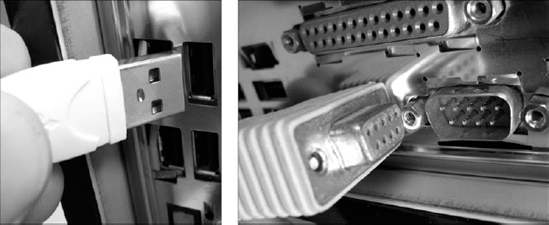
To install an external modem, follow these steps:
Plug either your new modem or its cable into your computer's USB port (left) or serial port (right), depending on its connection. Most modems plug into a USB port. If the plug doesn't push easily into the port, turn the plug upside down and try again. (Only friction holds the USB plug in place.)

Plug one end of your phone line into your wall's phone jack (left), and the other end into the jack on your modem (right). If your modem has two phone jacks, the phone jack labeled "Line" is for your telephone cable, and the one labeled "Phone" is for an optional telephone. No labels on your two jacks? Then just guess at which line plugs into which jack. If the modem or your phone doesn't work, swap the two plugs. (Having them wrong at first doesn't harm anything.)
If your modem plugs into a serial port (refer to Step 1, right), plug its power adapter into an outlet. Then turn on the modem's power switch. Modems that plug into a USB port don't need power.
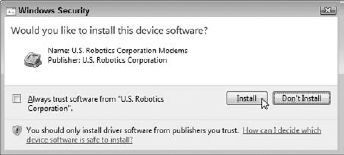
As soon as you turn on your newly plugged-in modem, Windows should recognize it and set it up for use. If Windows 7 starts asking for drivers, now's the time to insert the CD that came with your modem and let Windows install the drivers. (I cover driver mishaps in Chapter 17.)
When you're through, tell Windows 7 your ISP's dialup phone number, username, and password, a subject I cover in this chapter's "Helping Windows 7 Set Up a Dialup Modem" task.
Adding an internal modem takes a bit of work. You need to open your computer's case, push the new modem into an empty slot, screw the modem in place, and replace your computer's case. Don't want to bother? Then plug an external modem into a USB port, a far simpler chore described in the preceding task.
But if you're willing to open your computer's case, an internal modem is a wise investment. Internal modems cost less than half the price of external modems, and they're usually better quality. Plus, they never get lost, and you can't step on them, as you can with those tiny USB modems.
To install a modem inside your desktop computer, follow these steps:
Turn off your PC, unplug it, and remove your computer's case, as described in this book's Cheat Sheet, downloadable from
www.dummies.com/cheatsheet/upgradingandfixingcomputersdiy. If you're adding a new internal modem — not replacing your old one — jump to Step 4. Otherwise, proceed to Step 2.Look inside your computer and find your existing modem living in a plastic slot on your computer's flat, circuit-filled motherboard. See that row of metal slots toward the back of your computer's case? Those metal slots are where you plug in many of your computer's cables. Look to see where you plug in your phone cable — that's the back end of your internal modem card; the bottom of the card rests inside a slot.
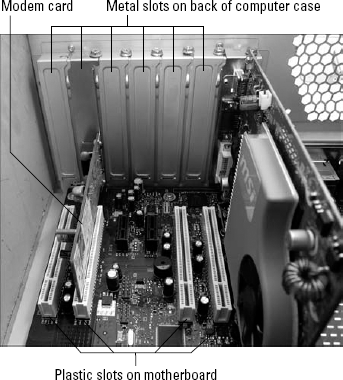
Remove your old modem card. With a small screwdriver, remove the single screw that holds that card in place. Save that screw, as you need it to secure the new card in place. After you remove the screw, only friction holds the card in its slot. Pull up on the card until it pops out of the slot. If you're adding a new card to an empty slot, remove the screw holding the cover in place and then remove the cover.
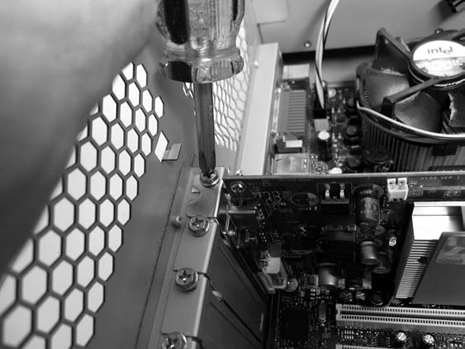
Push the new card into its slot. Line up the tabs and notches on the card's bottom with the notches in the slot. Push the card slowly into the slot. You may need to rock the card back and forth gently. When the card pops in, you can feel it come to rest. Don't force it!
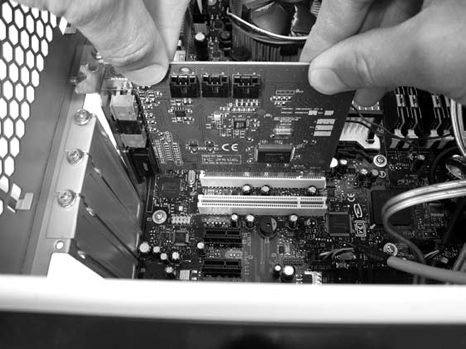
Tip
If you drop the screw inside your computer, poke it out with a screwdriver or chopstick. If that fails, shake your computer upside down until the screw falls out.
Secure the card in the slot with the screw you removed in Step 3. Yep, those delicate electronics are held in place by one screw.
Replace the computer's case, plug the computer back in, and turn it on. Windows usually recognizes newly installed cards and sets them up to work correctly. If your modem came with a CD, be sure to insert it when Windows 7 begins clamoring for drivers — translation software that helps Windows 7 talk to new parts.
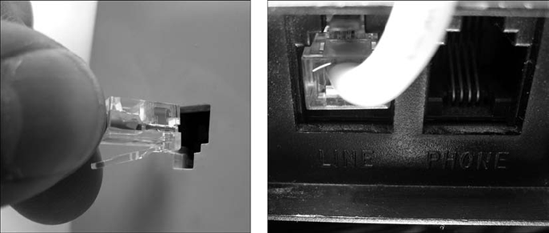
Connect a phone cable from the modem's Line jack to the phone jack in the wall. If you need a place to plug in your telephone, plug it into the modem's second phone jack — the one with the icon of the phone next to it.
After you've installed your dialup modem, you're not quite through. Whether you've plugged the modem inside your computer, plugged it into a USB port, or you're using a dialup modem already built into your computer, you still need to tell it the magic words that give you a connection.
And for dialup modems, those magic words are your ISP's dialup phone number, your username, and your password. (The username and password are usually the same as the ones you use for your e-mail.)
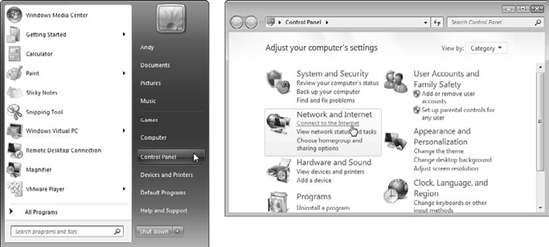
Click Start, choose Control Panel, and choose Connect to the Internet from the Network and Internet category.
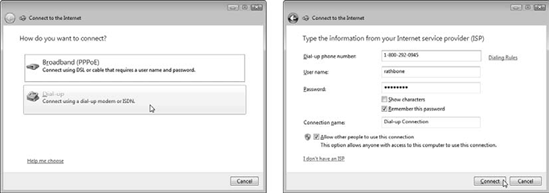
When the Connect to the Internet window appears, choose Dialup (left). Then enter your ISP's dialup phone number, your user name, and password (right). The username and password are usually the same as the ones used for your e-mail address. To make the connection available to everybody with an account on your computer, select Allow Other People to Use This Connection.
Load your Web browser and marvel at how long a Web page takes to fill the screen. Dialup access is slow, but it's better than nothing.
Tip
Do you need to enter a special number to reach an outside line? Then click Dialing Rules, enter your area code and carrier code or outside line prefix, and then click OK. Finally, click OK to save your changes.
Perhaps your ISP mailed you a new modem, with hints on how to install it. Maybe you're tired of paying your cable company a monthly rental fee for its cable modem, and you want to buy your own. Or perhaps your ISP sent you a notice saying your old modem must be replaced with a newer model. Either way, this task is for you.
If you're installing a cable modem, drop by your ISP's Web site to see when their technical support department is open. You must talk with your cable company's technical support people before your modem will work.
If you're installing a cable modem that contains a built-in router, it still installs the same way I describe here. Later, where I describe how to install a router in Chapter 15, you can conveniently ignore the step that says to attach a cable between the modem and the router: Yours is already attached!
Visit your ISP's Web site to see what modems it accepts, as not all broadband modems work with every provider. Then buy a modem brand and model that's compatible. You'll find many modems available online at Amazon (
www.amazon.com) or NewEgg (www.newegg.com). If your city has offered cable service for a year or so, you may find also cable modems available at computer stores and even home stereo stores.Choose a time to install the modem. If your cable company's open from 8 a.m.–5 p.m. only, for example, install the modem during those hours, as you'll need to call and ask them to authorize your modem. If your company offers 24-hour technical support, replace your modem in the late evenings or weekends so that you don't have to wait on hold so long.
Turn off the power to your computer and modem, unplugging the modem's adapter from the wall. Then plug the new modem's adapter into the wall and set the new modem next to your old modem.
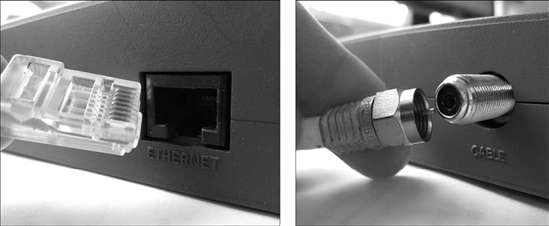
Unplug the cables from your old modem and plug them into the same spots on your new modem. You'll find two cables: a network cable (left) and a coaxial cable (right). The jacks fit only one way — the right way. (If you're installing a DSL modem, you'll insert a telephone cable instead of a coaxial cable. Don't put the DSL filter on the line that plugs into your modem!)
Turn on your new modem and turn on your computer. Don't panic when your new cable modem doesn't work. It's not supposed to work yet. Every cable modem has a MAC address (Media Access Control) — a special code number that enables the cable company to find it over the Internet. You often find your cable modem's MAC address on a sticker placed on its side or bottom. If it's not there, check the modem's box. Can't find it? Then hope your cable company's smart enough to be able to read the number from their end of the connection.
Call the cable company's technical support line and give them your new MAC address — a formality not required by DSL providers. The technical support people diligently type your new MAC address into their computers, replacing the old modem's MAC address. If your Internet service provider is really savvy, they'll be able to read your new modem's MAC address automatically, without your reading it to them.
Play FreeCell until your new modem starts working. It takes your cable company's network anywhere from a few seconds to several hours to start working. During this time, the new modem's lights will flash, frantically trying to find someone to talk to. When the cable modem finally connects, your browser and e-mail program start working again. Whew!
